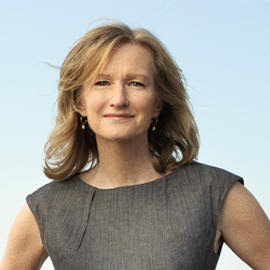Q&A With Deborah Brooks, Executive Vice Chair of Fox Foundation

Credit: FREELY ART/Shutterstock
Deborah W. Brooks, a former vice president at Goldman Sachs, had always had a “tug” toward nonprofit work, and after watching enough gala videos that brought her to tears, she decided to fully invest in a cause. A first meeting with the actor Michael J. Fox led her to Parkinson’s.
“We clicked the day we met,” Brooks recalled, now evidenced by a 21-year stint at the Michael J. Fox Foundation for Parkinson’s Research, which she helped to establish with Fox in 2000, and went on to serve as its founding CEO until 2007.
In her current role as executive vice chairman, Brooks guides fundraising, communication, and marketing for the foundation, which focuses on translational research — that is, getting therapies from the basic research stage into human studies.
In an interview with Parkinson’s News Today, Brooks spoke about how she transitioned into nonprofit work, the diversity of treatments coming down drug development pipelines, and future goals of the Fox Foundation.
Parkinson’s News Today: How did you come to team up with the Michael J. Fox Foundation? What was the inspiration?
Deborah Brooks: I knew already that a lot of nonprofits weren’t in a position to use their capital strategically, because they couldn’t raise very much or they just didn’t have the staff. And so I had this view that, with my background and my passion, I’d want to be part of something that could do that. Another observation I’d had is it’s really rare for a nonprofit to scale, like beyond a $2 million to $3 million budget, seven to 10 employees. That’s a pretty classic model.
When I got a call about this opportunity through a former colleague of mine at Goldman Sachs, as soon as I heard Michael’s name, I thought that might have a chance to scale. So it kind of combined my view that more and more nonprofits, if given the chance, if they had strategic leadership and kind of strategic underpinnings, they would scale. That’s what excited me.
PNT: What excites you most about the research pipeline? Where do you see the most promise?
DB: In the last seven years, we’ve had 17 newly approved treatments. That is stunning and exciting, given the variability of Parkinson’s disease. For an individual patient, they don’t really see 17 new things, because not everything is for everybody at every time of their disease course.
We continue to have even more novel ways to manage symptoms, particularly symptoms that don’t benefit or respond well to our classic dopaminergic-based drugs. But we also have a really robust set of trials going after disease modification, [but] nothing has yet gone over that goal line. There’s no treatment anywhere in the world that’s been approved that goes after the underlying disease course.
We have specific trials that are targeting Parkinson’s with LRRK2 [mutations], Parkinson’s with GBA. It’s not where the cancer field is, but it’s starting to look a little bit more like, ‘Wow, we have some real tangible ways where we can see that a target, a biological target, is playing a role in Parkinson’s disease manifestation and can we alter that target directly.’ Shifting from managing symptoms to actually going after these biological targets is huge.
PNT: How is your emphasis on the business of science making the transition from bench to bedside faster?
DB: I do think there is science and the business of science, and so it’s understanding how an idea kind of starts as a spark and not wanting to choke down the flame of that spark. You still have to be practical and figure: ‘OK, but what does it take?’
In our parlance, we refer to that as de-risking an idea. What are the smart steps to put as much data around that concept, and keep showing that positive data to as many possible investors, so that you give ideas as much chance as possible?
PNT: Why, as a Parkinson’s organization, have you also expressed an interest in Alzheimer’s?
DB: I think a lot of the field in neuroscience thinks that Alzheimer’s is a little further ahead. It’s certainly further ahead in terms of capital that’s been deployed in the last 20 to 30 years.
One area where Alzheimer’s is definitely ahead is being able to visualize the pathology that’s relevant in Alzheimer’s in a living brain, and getting insights like that just transform how drug development gets executed. Why that matters is if you can make insights around how to think about targeting an area in the brain and what the implications are for who should be in your trial, how many people should be in the trial, and how long you need to follow them.
These are all things that can come from those kinds of insights, being able to visualize something in the brain. It transforms how you design your trial, and who you pick to go into it.
We would love to see that parallel kind of achievement, and we’re going after it — being able to visualize, for instance, the clumped alpha synuclein in the brain of living Parkinson’s patients. We’ve known for a while [that] if we could get that, it would be a game-changer. And we’ve spent tens of millions of dollars going after it. But it’s just hard.
PNT: What was your goal for this year in terms of funding? What milestones are you hoping to hit for the foundation and Parkinson’s research in the next five years?
DB: Just like most nonprofits, we had to change some of the ways in which we raise money [in 2020]. Thousands of events ultimately got canceled when it was all said and done, small and large. And that certainly impacted how we raise money, but it also impacted just staying connected to our community.
I found the resilience of our community impressive. I mean, this has been a challenging year for so many, but among people for whom we are one of their top causes, we can see it in our numbers — while the number of gifts is down, the size of the gifts have gone up.
We have funded over a billion dollars worth of research since we started in 2000. And to be honest, if you had me put a number on it, I couldn’t have imagined this. But no surprise, a billion dollars doesn’t go so far in research. So when I look at what’s been accomplished with that, I’m really proud. Having a transformed pipeline with the diversity that we talked about before is a pretty good place to be.
I’d imagine in the next five years, we have a chance that something in disease modification may get over the goal line.






